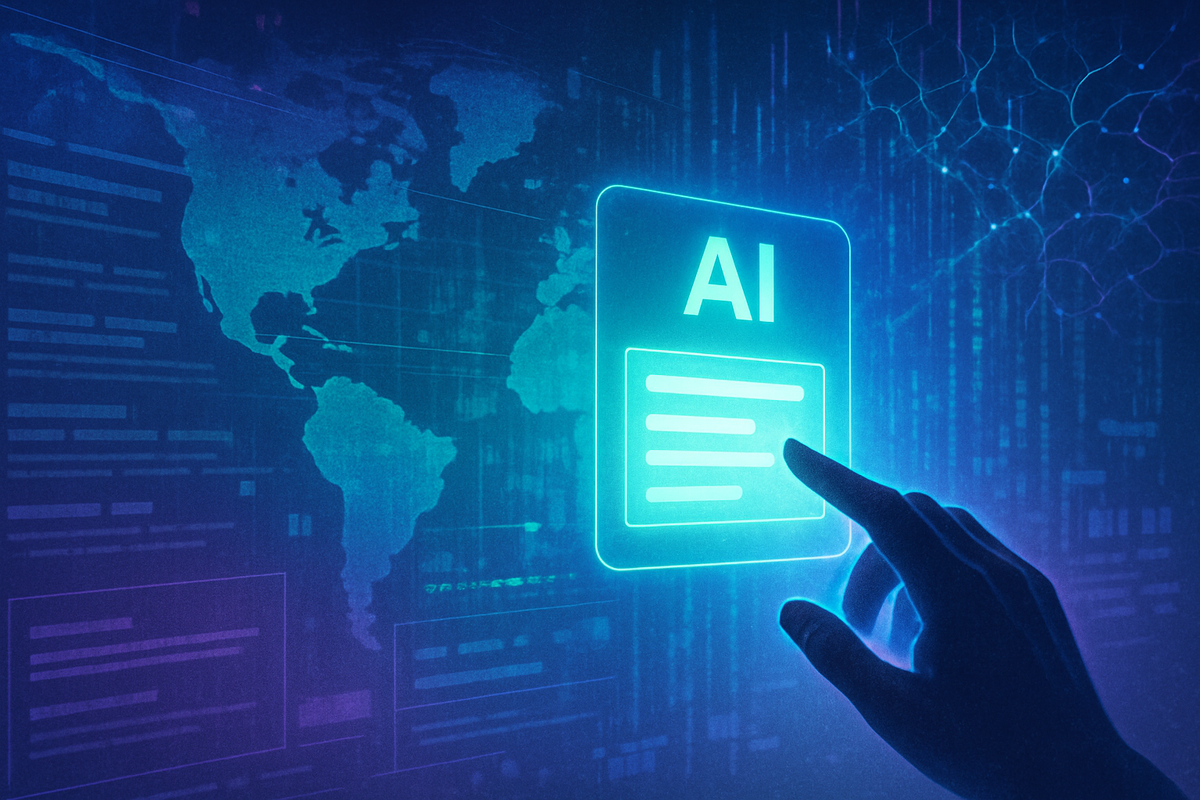Financial News
'AI Mode' Ushers in the Biggest Web Transformation in Two Decades, Reshaping Search and Journalism

The digital landscape is undergoing its most profound transformation in 20 years, as the advent of "AI Mode" fundamentally redefines how users interact with online information and poses an existential challenge to traditional news publishers. This sophisticated, AI-driven search experience, pioneered by tech giants like Google (NASDAQ: GOOGL), promises users direct, comprehensive, and conversational answers, moving beyond the traditional link-based search paradigm. While offering unparalleled efficiency and personalization, this shift is simultaneously triggering a seismic disruption across the media industry, threatening established revenue models and forcing a radical re-evaluation of content creation and distribution strategies.
At its core, AI Mode represents a paradigm shift from a web of links to a web of answers. Users are increasingly receiving AI-generated summaries and direct information within the search interface itself, significantly reducing the incentive to click through to external websites. This phenomenon, often termed "zero-click searches," is already leading to a dramatic decline in referral traffic for news organizations and content creators, jeopardizing their advertising revenue and challenging the very foundation of digital journalism. The implications are far-reaching, demanding urgent adaptation from publishers and presenting both immense opportunities and formidable obstacles for the future of online information and financial markets.
The Genesis of an AI-First Web: A Timeline of Transformation
The current "AI Mode" phenomenon is not an overnight sensation but the culmination of decades of relentless innovation in artificial intelligence. From the rudimentary keyword matching of early search engines in the late 1990s to the integration of machine learning for improved relevance in the 2000s, the path has been steadily paved. A pivotal moment arrived with the development of advanced language models like BERT (Bidirectional Encoder Representations from Transformers) in 2018, enabling search engines to grasp query intent with unprecedented human-like understanding. However, the true inflection point was the generative AI boom ignited by OpenAI's (private) release of ChatGPT in November 2022, which showcased the power of large language models (LLMs) to generate coherent, contextual, and conversational responses, setting off an arms race among tech giants.
Google, a long-standing titan in search, has been at the forefront of this evolution with its "AI Overviews," formerly known as the Search Generative Experience (SGE). First announced in May 2023 as an experiment in Search Labs, AI Overviews rapidly evolved, rolling out to U.S. users in May 2024 and expanding globally by August 2024. By May 2025, Google had fully rolled out AI Mode to everyone in the U.S., fundamentally altering the search results page. Key features include AI-powered snapshots that provide summarized answers at the top of results, a conversational mode for follow-up questions, and vertical experiences for shopping and coding. While promising enhanced user experience, the initial rollout faced criticism for occasionally generating "dangerous and wrong answers," highlighting the inherent challenges in deploying such advanced AI at scale.
Microsoft (NASDAQ: MSFT) has aggressively pushed its "Copilot" initiative, embedding AI across its ecosystem. Launched in February 2023 as Bing Chat, Copilot, powered by OpenAI's GPT-4, quickly evolved to integrate with Microsoft 365 applications like Word, Excel, and PowerPoint, becoming generally available for enterprises by November 2023. By October 2025, stable releases of Microsoft Copilot were widely available across Windows, macOS, iOS, and Android. Beyond conversational AI, Copilot leverages DALL-E 3 for image generation and aims to significantly boost productivity. The company's commitment to an AI-first future was underscored by the announcement of a dedicated Copilot key on Windows keyboards in January 2024.
OpenAI, the catalyst for the current generative AI wave, has transformed its flagship ChatGPT into a formidable search contender. Initially a conversational chatbot, ChatGPT gained real-time web search functionality for paid subscribers by October 2024, expanding to all logged-in users worldwide by December 2024. This integration allows ChatGPT to provide current web data, including news and stock prices, with citations, directly within its conversational interface. Similarly, Apple (NASDAQ: AAPL) introduced "Apple Intelligence" in late 2024, integrating generative AI across its devices for writing tools, an improved Siri, and notification summaries, with a projected internal AI search solution, "World Knowledge Answers," by March 2026. Even e-commerce giant Amazon (NASDAQ: AMZN) has launched AI-powered shopping assistants like "Rufus" and "Interests" by mid-2024, transforming product discovery. These rapid advancements underscore a collective industry pivot towards intelligent, personalized, and conversational digital experiences, profoundly impacting how users interact with information, productivity tools, and commerce.
The Shifting Sands of Fortune: Winners and Losers in the AI-First Era
The seismic shift ushered in by AI Mode is creating a clear delineation between potential winners and those facing significant headwinds in the financial markets. Companies at the forefront of AI development and infrastructure are poised for substantial gains, while traditional content creators and those reliant on legacy web traffic models face an urgent need to adapt or risk obsolescence.
At the top of the list of beneficiaries are the Search Engine Providers themselves, primarily Alphabet (NASDAQ: GOOGL) and Microsoft (NASDAQ: MSFT). By integrating generative AI into their core search offerings—Google's AI Overviews and Microsoft's Copilot—these tech behemoths aim to enhance user experience, thereby solidifying their market dominance. While concerns exist about the cannibalization of traditional ad clicks, both companies are actively pioneering new monetization strategies, such as AI-native ads directly within generative answers, which Microsoft has reported can yield higher click-through and conversion rates. Their vast data sets, existing user bases, and formidable R&D capabilities provide an almost insurmountable competitive advantage in this evolving landscape.
Closely following are the Cloud Computing Providers and AI Chip Manufacturers. The immense computational power required to train and deploy sophisticated AI models translates directly into soaring demand for services from Amazon (NASDAQ: AMZN) through its Amazon Web Services (AWS), Microsoft (NASDAQ: MSFT) with Azure, and Google Cloud (part of Alphabet - NASDAQ: GOOGL). These cloud giants are witnessing significant revenue growth fueled by AI investments. Crucially, NVIDIA (NASDAQ: NVDA), the undisputed leader in graphics processing units (GPUs), stands as a colossal winner. Its GPUs are the fundamental building blocks for AI, and the insatiable demand for these chips continues to drive its market valuation to unprecedented heights. Furthermore, e-commerce titans like Amazon (NASDAQ: AMZN) are leveraging AI extensively, integrating conversational AI shopping assistants like "Rufus" to hyper-personalize the shopping experience and drive sales, further cementing their market positions.
Conversely, the widespread adoption of AI Mode presents a dire challenge to Traditional Content Publishers and Media Companies. News organizations, blogs, and independent publishers, whose business models are heavily predicated on organic search traffic and subsequent advertising revenue, are experiencing "devastating" drops in click-through rates (CTR) to their websites. Some studies report declines ranging from 56% to a staggering 89% when AI Overviews are present, leading to an estimated annual loss of approximately $2 billion for the publishing industry. This erosion of traffic directly impacts ad impressions and, consequently, their primary revenue streams. Their traditional competitive advantage of "owning" the content and attracting direct readership is severely undermined as AI synthesizes and presents information directly.
Similarly, other Companies Highly Reliant on Organic Search Traffic, such as niche e-commerce sites, lead generation platforms, and affiliate marketers, face reduced visibility and potential disintermediation. The "zero-click search" phenomenon, where users find complete answers on the search results page, bypasses the need to visit external sites, thereby diminishing opportunities for direct sales or lead capture. Even Traditional Advertising Technology Companies, particularly those focused on display ads across third-party websites, may encounter reduced inventory and demand as user engagement shifts from external sites to AI-powered search interfaces. These entities must urgently pivot their strategies, focusing on optimizing content for AI interpretation, diversifying traffic sources, and exploring new monetization models beyond conventional display advertising.
A New Digital Order: Broad Implications and Regulatory Crosscurrents
The integration of "AI Mode" into the fabric of web search represents more than just a technological upgrade; it signifies a fundamental reordering of the digital information ecosystem, with profound implications for industry trends, competitive dynamics, and the regulatory landscape. This shift aligns with the overarching generative AI revolution, transforming user expectations from a directory of links to a dynamic, conversational dialogue with the web. Users now anticipate immediate, synthesized answers to complex queries, a behavior fueled by the ubiquity of voice assistants and personalized content feeds.
This intensified competition is already reshaping the market. Google (NASDAQ: GOOGL), long the undisputed monarch of search, faces formidable challenges from AI-native contenders like OpenAI (private) with ChatGPT Search and Perplexity.ai (private), as well as integrated AI offerings from Microsoft (NASDAQ: MSFT) Copilot and Apple (NASDAQ: AAPL) Intelligence. This fierce rivalry is accelerating innovation, forcing every player to continuously refine their AI capabilities to offer the most accurate, comprehensive, and engaging conversational search experiences. For digital marketers, the focus has irrevocably shifted from mere keyword optimization to understanding the full user journey and crafting content that satisfies deeper informational needs, often in multimodal formats.
The ripple effects extend deeply into the content creation sphere. Publishers and content creators are grappling with significantly reduced referral traffic, as AI-generated summaries on search results pages diminish the incentive for users to click through to original sources. Reports of click-through rate (CTR) declines, sometimes exceeding 40-50%, are forcing a critical re-evaluation of content strategies. Survival hinges on creating unique, high-value content that is difficult for AI to replicate, optimizing for conversational and multimodal search, diversifying traffic sources beyond search engines, and cultivating direct, loyal audience relationships. For advertisers, the landscape is also evolving; while traditional display ad inventory on third-party sites may shrink, new opportunities are emerging within AI-generated search summaries, demanding adaptive strategies for inclusion in these novel ad formats.
Crucially, AI Mode raises a litany of complex regulatory and policy implications. Copyright stands as a major battleground, with lawsuits from prominent entities like The New York Times (NYSE: NYT) against OpenAI and Microsoft, and Getty Images (NYSE: GETY) against Stability AI, alleging infringement from AI models trained on vast swaths of copyrighted internet data. The legal debate over "fair use" versus unauthorized appropriation of intellectual property is expected to intensify, while the copyrightability of AI-generated content itself remains a thorny issue. The proliferation of misinformation and disinformation is another critical concern, as AI tools can rapidly generate realistic fake content, exacerbating the challenge of distinguishing truth from fabrication. This necessitates robust fact-checking mechanisms, digital watermarking, and enhanced media literacy initiatives. Furthermore, concerns around data privacy and transparency are mounting, prompting calls for greater explainability in AI algorithms and strict adherence to regulations like GDPR and CCPA. The potential for a few dominant players in AI search to further consolidate market power also raises significant competition policy questions, inviting antitrust scrutiny to ensure a fair and open digital market.
Historically, this transformation echoes the profound shifts that have periodically reshaped the web. It is arguably the most significant change since Google's PageRank algorithm revolutionized search in the late 1990s, moving beyond simple keyword matching to evaluate content importance. The current transition from a "web of links" to a "web of answers" represents a similar step-change, amplifying the "zero-click" trend seen with earlier featured snippets. This is not merely an incremental update but a fundamental re-imagining of information discovery, presenting both immense progress and formidable challenges for the future of digital information.
Navigating the New Horizon: The Future of AI Search and Journalism
The trajectory of AI search promises a future of both profound disruption and unprecedented opportunity, compelling news organizations to strategically pivot or face irrelevance. In the short term, the "Google Zero" phenomenon, where AI-powered search provides direct answers without sending users to external sites, is accelerating. Reports from entities like TollBit indicate a staggering 95.7% less click-through traffic from AI search bots compared to traditional Google searches, a trend unlikely to be offset by emerging AI platforms. This immediate decline in referral traffic directly impacts news publishers' core advertising revenue, demanding urgent adaptation. Simultaneously, AI is already transforming newsrooms internally, automating tasks like transcription and data analysis, thereby freeing journalists to focus on in-depth reporting and creative storytelling, albeit with new challenges concerning misinformation and copyright.
Looking further ahead, the long-term outlook suggests a "post-search web" where content is synthesized by machines, shifting control over audience access to platform companies and AI providers. This necessitates a fundamental re-evaluation of content creation and distribution, moving beyond static articles to "elastic content" that can be customized and personalized by AI for individual readers. While AI holds the potential to augment journalists, making them more efficient in data handling and content personalization, it also raises ethical concerns around algorithmic bias and transparency, underscoring the need for "algorithmic literacy" within newsrooms. The ability to responsibly harness AI and maintain a commitment to truth will be paramount.
To survive and thrive, news organizations are undertaking critical strategic pivots. A primary focus is shifting from traditional SEO to "Generative Engine Optimization" (GEO), which involves structuring content to be easily comprehensible and citable by AI models, often with a strong presence on social platforms that AI companies crawl. Building direct audience relationships through subscriptions, newsletters, and proprietary apps, as exemplified by The Times & Sunday Times (LSE: NWS), is becoming crucial to mitigate reliance on third-party search traffic. Publishers are also prioritizing original, investigative, and local news content that offers unique value difficult for AI to replicate, while simultaneously exploring strategies for content protection and licensing deals with AI developers for fair compensation. Internally, newsrooms are embracing AI tools for efficiency, innovation, and even generating first drafts, alongside diversifying revenue streams beyond advertising to include events, affiliate marketing, and donations.
For emerging markets, AI presents a dual-edged sword. Opportunities abound for increased efficiency, content personalization, and even "leapfrogging" traditional development stages. However, challenges such as intense competition for AI talent, knowledge gaps, lack of funding for innovation, and inadequate infrastructure persist. Potential scenarios for the future range from a bleak outcome where AI platforms completely dominate information access, rendering news sites invisible without strategic partnerships, to an "augmented journalism" model where AI empowers human journalists to deliver deeper, more personalized, and impactful reporting. Another scenario envisions "elastic content" and personalized news feeds boosting engagement, especially among younger demographics. Conversely, there's a risk of increased polarization and misinformation if AI is not managed responsibly. Ultimately, the future will likely reward news organizations that can deeply embed AI into their operations, reskill their workforce in AI management and ethics, and forge new business models and collaborations that ensure the continued vitality of quality journalism.
The AI-First Web: A New Era of Information and Investment
The integration of "AI Mode" into the core of web search marks the most significant evolution of the internet in two decades, transforming it from a mere directory of links into an intelligent, adaptive knowledge ecosystem. The era of "zero-click searches" is upon us, fundamentally altering how users discover information and creating an urgent imperative for content creators and businesses to adapt. This shift promises unparalleled efficiency and personalization for users but simultaneously presents an existential challenge to traditional online business models reliant on advertising revenue derived from organic search traffic.
Moving forward, the market will increasingly reward innovation in AI infrastructure, generative AI applications, and adaptive content strategies. The traditional web design and SEO paradigms are being upended, demanding simpler, AI-friendly interfaces and content optimized for machine understanding and conversational search. While the "zero-click revolution" threatens to diminish revenue for many publishers, it also spurs an "innovation paradox," challenging them to create high-quality, original content that AI models themselves need, while finding new monetization avenues beyond traditional advertising. The long-term impact will redefine information quality, diversity, and access, raising critical ethical questions about data privacy, misinformation, and the societal implications of an AI-filtered world.
Investors should closely monitor companies providing core AI infrastructure, such as cloud platforms like Amazon Web Services (AWS), Microsoft Azure, and Google Cloud, and AI chip manufacturers like NVIDIA (NASDAQ: NVDA), as their demand will only intensify. Furthermore, watch for generative AI startups and platforms pushing the boundaries of content creation and automation, as well as innovators in AI-powered browsing and search that challenge established players. Companies offering solutions for "Generative Engine Optimization" (GEO) and those successfully building direct audience relationships and diversifying revenue streams will prove resilient. Finally, the evolving regulatory landscape surrounding copyright, misinformation, and competition will significantly shape the industry, making ethical AI and trustworthy content solutions increasingly valuable. The coming months will be crucial in observing how swiftly industries adapt to this AI-first web and how new economic models emerge to sustain a vibrant digital information landscape.
This content is intended for informational purposes only and is not financial advice
More News
View More



Recent Quotes
View More
Quotes delayed at least 20 minutes.
By accessing this page, you agree to the Privacy Policy and Terms Of Service.



